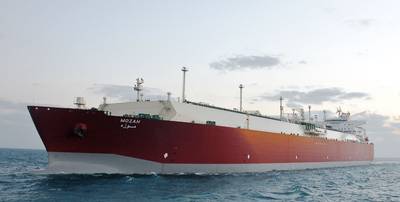Qatar's Bigger LNG Expansion to Squeeze US, Other Rivals
Qatar's planned expansion of liquefied natural gas (LNG) production could see it control nearly 25% share of the global market by 2030 and squeeze out rival projects including in the United States where President Biden paused new export approvals, market experts say.
Qatar, one of the world's top LNG exporters, plans an 85% expansion in LNG output from its North Field's current 77 million metric tons per year (mtpa) to 142 mtpa by 2030, from previously expected 126 mtpa.
Some market experts said that the move will have an impact on global projects in the United States, East Africa, and elsewhere which requires financing and long-term customers commitment to reach final investment decision (FID), given Qatar's edge as the world's lowest cost producer.
Analysts estimate Qatar's unit cost of LNG production to be as low as $0.3/mmBtu, versus $3-$5/mmBtu globally, as associated liquids production pays for most of the LNG construction costs, and as access to cheap labour from southeast Asia prevents projects ballooning in cost or slipping behind schedule.
"The Qataris realised that they should be able to offer pretty much the most competitive prices. They have the reserves, lower costs for building incremental capacity, the relationship with engineering firms and existing clients, so why stop here?," said Ira Joseph, Senior Research Associate at Columbia University's Center on Global Energy Policy.
"This suggests that they are hurtling into use it or lose it mode. If you're the world's low cost producer, why not throw down the hammer & scare away any competition that's requiring long-term customers and financing," he added.
Fraser Carson, Senior Research Analyst of Global LNG at Wood Mackenzie said the timing of Qatari announcement is "fortuitous", as other major LNG competitors stall, in light of the Biden administration's pause of U.S. LNG export approvals, sanctions on Russian LNG and as civil unrest continues in Mozambique.
Competition between Qatar and the United States intensified following Europe's decision to wean off dependence on Russia's pipeline gas following its invasion of Ukraine, as U.S. gas suppliers filled the supply vacuum, establishing themselves as the world's biggest LNG exporter in 2023, surpassing Qatar, though Qatari supplies also helped replace the volumes.
The U.S. LNG capacity will almost double over the next four years, but a decision to pause approvals for applications for new LNG export terminals, for environmental reviews, has prompted warnings from gas importers that the move would compromise future energy security worldwide.
"The signal the U.S. projects need to take from this (is): if they don't go ahead, someone will," said Kaushal Ramesh, Rystad Energy's vice president for LNG research.
Asia'a growth horizon
The new expansion is expected to lead to a period of more stable, lower prices across the rest of the decade and would encourage greater take-up of LNG from Asian buyers, said Alex Froley senior LNG analyst at data intelligence firm ICIS.
"Bringing online 16 mtpa of low cost volumes is positive for Asia and is exactly what the LNG market needs to guarantee a long-term future in emerging Asia", Rystad's Ramesh said.
Global gas market will grow to 580-600 mtpa by 2030, from current 400 mtpa, mainly driven by Asian demand. Qatar is expected to control 24-25% of the market by then.
"Qatar is geographically well placed to meet current high demand in Northeast Asia in China, Japan and Korea and future demand in the only real growth region of South Asia, especially in India," said Henning Gloystein, Practice Head, Energy and Resources at Eurasia Group.
QatarEnergy chief Saad al-Kaabi said on Sunday that he still believes that there is ample opportunity for gas to be part of the energy mix in the future: "We think there will be a shortage of gas, even with our project".
While there are concerns over the additional carbon emissions impact from new global LNG production, Others argue that there is still huge scope for gas to reduce emissions by replacing coal and oil, ICIS' Froley said.
Despite being the world's largest LNG importer last year, China's overall energy mix is only around 8% gas against 61% for coal and 18% for oil, for example, he added, citing IEA figures.
"For coal to be replaced by gas delivered as LNG as the primary fuel in Asian thermal power plants, the LNG price and price stability is critical. Volatility will make coal to gas conversion more difficult," said Morten Frisch, senior partner at Morten Frisch Consulting.
The world's top energy companies including Exxon Mobil, Shell, TotalEnergies and ConocoPhillips have played a central role in Qatar's LNG industry for decades. They all hold stakes in existing production facilities and in recent years acquired stakes in the new expansion phases, offering cash in exchange for LNG volumes.
While the new contracts are not as lucrative as in the past, according to industry sources, they offer the companies an important foothold in the LNG industry, which they expect will continue to grow in the coming decades as economies shift from coal to less polluting natural gas.
Industry sources expect Qatar to continue to seek partnerships with global players as it has a lot of LNG volumes to sell, with one source expecting Australia's Woodside, whose U.S. Lake Charles project is under threat by Biden's pause, might seek to become a Qatari partner, given they have recently shelved plans for a $52 billion tie-up with smaller rival Santos.
(Reporting by Marwa Rashad; Additional reporting by Ron Bousso in London and Andrew Mills in Doha, Editing by Nina Chestney and David Evans)















